
Pinus parviflora, also known as five-needle pine, or Japanese white pine, is a pine in the white pine group, Pinus subgenus Strobus, native to Japan.
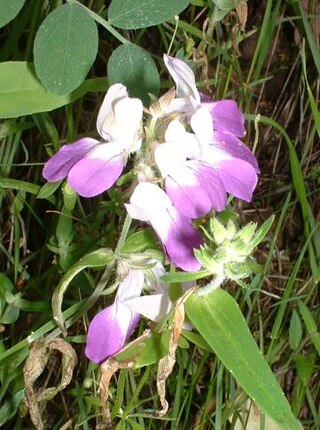
Collinsia is a genus of about 20 species of annual flowering plants, consisting of the blue eyed Marys and the Chinese houses. It was traditionally placed in the snapdragon family Scrophulariaceae, but following recent research in molecular genetics, it has now been placed in a much enlarged family Plantaginaceae.
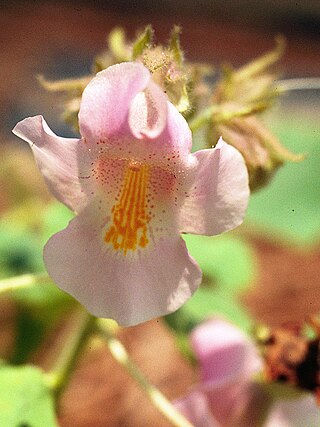
Proboscidea is a genus of flowering plant in the family Martyniaceae, some of whose species are known as devil's claw, devil's horn, ram's horn, or unicorn plant. The plants produce long, hooked seed pods. The hooks catch on the feet of animals, and as the animals walk, the pods are ground or crushed open, dispersing the seeds. The name devil's claw is shared with the South African plant Harpagophytum procumbens.

Crossosomataceae is a small plant family, consisting of four genera of shrubs found only in the dry parts of the American southwest and Mexico. This family has included up to ten species in the past, although as of 2021 six species are still recognised. Crossosoma are shrub-like plants which can vary from being 50 cm to 5 meters tall, with small alternating leaves that surround the stem, or leaves clustered in small spurts (fascicles). Apacheria, however, has opposite leaves. Crossosoma has usually white flowers that are generally bisexual and have 5 petals attached to a nectary disk, but in Velascoa the flowers are campanulate and have an extremely reduced nectary disk.

Aesculus parviflora, the bottlebrush buckeye or small-flowered buckeye, is a species of suckering deciduous shrub in the family Sapindaceae. The species is native to the southeastern United States, where it is found primarily in Alabama and Georgia, with a disjunct population in South Carolina along the Savannah River. Its natural habitat is in mesic forests, on bluffs and in ravines.

Oenothera curtiflora, known as velvetweed, velvety gaura, downy gaura, or smallflower gaura, is a species of flowering plant native to the central United States and northern Mexico, from Nebraska and Wyoming south to Durango and Nuevo Leon.

Galinsoga parviflora is a species of herbaceous plant in the daisy family Asteraceae. It has several common names including guasca (Colombia), pacpa yuyo, paco yuyo, and waskha (Peru), burrionera (Ecuador), albahaca silvestre and saetilla (Argentina), mielcilla, piojito, galinsoga, gallant soldier, quickweed, and potato weed.
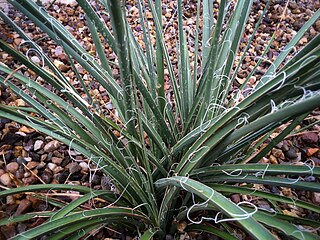
Hesperaloe parviflora, also known as red yucca, hummingbird yucca, redflower false yucca and samandoque, is a succulent plant in the Asparagaceae family that is native to the Chihuahuan and Coahuilan deserts of Northern Mexico, as well as Central, Southern and Western Texas; today, it is often seen in roadside planting swathes and public areas, or used for corporate or office exterior landscaping. It is also quite popular in collector gardens and among private gardeners who are striving for a more water-wise approach.

Hopea parviflora is a species of plant in the family Dipterocarpaceae. It is endemic to India. It is called 'kampakam' or 'thampakam' in Malayalam and கோங்கு 'vellaikongu' or 'irubogam' in Tamil. Hopea parviflora is a tree growing 30 – 37 metres tall. The bole can be 150 cm in diameter. The tree produces a beautiful timber and is commonly harvested from the wild, both for local use and for trade. The plant is classified as 'Least Concern' in the IUCN Red List of Threatened Species.

Vitex parviflora is a species of plant in the family Lamiaceae, also known as smallflower chastetree or the molave tree. The name "molave" is from Spanish, derived from mulawin, the Tagalog word for the tree. It is also known as tugas in Visayan languages. It yields one of two woods from the same genus called molave wood, the other being Vitex cofassus.

Collinsia parviflora is a species of flowering plant in the family Plantaginaceae known by the common names maiden blue eyed Mary and small-flowered collinsia.
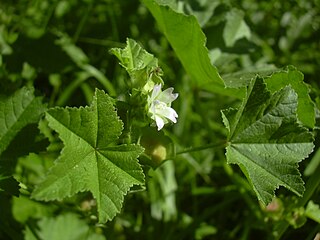
Malva parviflora is an annual or perennial herb that is native to Northern Africa, Southern Europe, and Western and Central Asia and is widely naturalised elsewhere. Common names include cheeseweed, cheeseweed mallow, Egyptian mallow, least mallow, little mallow, mallow, marshmallow, small-flowered mallow, small-flowered marshmallow, Nafa Shak, and smallflower mallow.

Agrimonia parviflora is a species of perennial herbaceous flowering plant. Small-flowered agrimony, harvestlice agrimony, swamp agrimony, and harvestlice are its most common names in the United States.

Tamarix parviflora is a species of tamarisk known by the common name smallflower tamarisk.

Phyllostegia parviflora is a rare species of flowering plant in the mint family known by the common name smallflower phyllostegia. It is endemic to Hawaii, where it is known from Maui, Oahu, and the island of Hawaii. It is a federally listed endangered species of the United States.

Agave parviflora is a species of succulent perennial flowering plant in the asparagus family, known by the common names Santa Cruz striped agave, smallflower century plant, and small-flower agave. It is native to Arizona in the United States and Sonora in Mexico.

Setaria parviflora is a species of grass known by the common names marsh bristlegrass, knotroot bristle-grass, bristly foxtail and yellow bristlegrass. It is native to North America, including Mexico and the United States from California to the East Coast, Central America and the West Indies, and South America.

Halesia carolina, commonly called Carolina silverbells or little silverbells, is a species of flowering plant in the family Styracaceae, native to the southeastern United States.
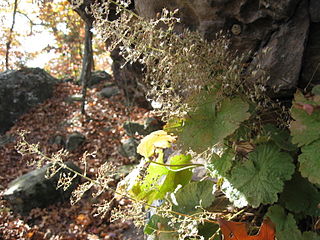
Heuchera parviflora is a species of flowering plant in the saxifrage family known by the common names cave alumroot and littleflower alumroot. It is native to the eastern United States, where it is found primarily in the Ozark Mountains, Appalachian Mountains, and Cumberland Plateau. It is found in deeply shaded areas such as under rock overhangs and cliffs, almost always where no direct sunlight falls. In this habitat, it is often the only vascular plant found. H. parviflora is an uncommon species throughout its range. It flowers in late summer through fall.

Maxillaria parviflora, the purple tiger orchid, is a species of epiphytic orchid native to Florida, the West Indies and through Latin America from Mexico to Bolivia.



















